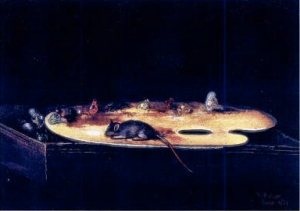 In 1871 a mouse ran onto the palette of William Aiken Walker and posed at the edge in front of dabs of lead white, Van Dyke Brown and vermillion. Witnessing the tiny creature’s bustle was the painter himself. Now inspired, Walker picked up his brush and transformed the moment into oil on board, measuring 12 x 16 inches. The Surprize [sic] is complete with the small rodent’s tail colored red from his shortcut through the vermillion.[1] Walker would go on to paint Old Shoe with Mice, in which a handful of critters gnaw holes in the footwear’s leather. And in 1872, Walker showed more mice, this time on a tabletop, joyfully devouring fruit and crackers; he called that painting A Free Lunch. Four years later, hungry mice still seemed to be on Walker’s mind when he painted another group feasting on a generous wedge of cheese, fruit and nuts. Still Life with Cheese, Bottle and Mouse—with the cheese, a common symbol for longevity, now half-eaten—ostensibly sounds like the stuff of a vanitas, an homage perhaps to the seventeenth century Dutch artists as Walker had recently spent time in Europe visiting artists studios, galleries and museums, looking at works “on which he based [several of] his own still-life paintings.”[2] But from all appearances the rodents of this Charleston, South Carolina-born painter were not, as they were in Holland, reminders of the impermanence of earthly life as much as they were reminders of the mouse’s sybaritic nature.
In 1871 a mouse ran onto the palette of William Aiken Walker and posed at the edge in front of dabs of lead white, Van Dyke Brown and vermillion. Witnessing the tiny creature’s bustle was the painter himself. Now inspired, Walker picked up his brush and transformed the moment into oil on board, measuring 12 x 16 inches. The Surprize [sic] is complete with the small rodent’s tail colored red from his shortcut through the vermillion.[1] Walker would go on to paint Old Shoe with Mice, in which a handful of critters gnaw holes in the footwear’s leather. And in 1872, Walker showed more mice, this time on a tabletop, joyfully devouring fruit and crackers; he called that painting A Free Lunch. Four years later, hungry mice still seemed to be on Walker’s mind when he painted another group feasting on a generous wedge of cheese, fruit and nuts. Still Life with Cheese, Bottle and Mouse—with the cheese, a common symbol for longevity, now half-eaten—ostensibly sounds like the stuff of a vanitas, an homage perhaps to the seventeenth century Dutch artists as Walker had recently spent time in Europe visiting artists studios, galleries and museums, looking at works “on which he based [several of] his own still-life paintings.”[2] But from all appearances the rodents of this Charleston, South Carolina-born painter were not, as they were in Holland, reminders of the impermanence of earthly life as much as they were reminders of the mouse’s sybaritic nature.
But why, we might ask, would the quintessential artist of the South—allegedly a bit of a dandy who became recognized as one of the most important Southern genre painters with his oft-controversial homey depictions of African-American sharecroppers[3]—take time to portray over and over the tiny rodent?
His preoccupation with mice appears to be a perpetuation of the subject matter that he painted in his teens and his early twenties prior to the Civil War, when he exhibited works of animals, fish and fowl, chickens and cows, and portraits of dogs. The artist’s biographers note that Walker’s visual narratives of mice “reflect his interest in the insignificant as well as his quiet sense of humor.”[4]
On the other hand, inasmuch as he was an artist, he was also a savvy businessman ready to meet his clients’ demands. From Baltimore to Alabama, New Orleans to North Carolina, Tallahassee to Tennessee he roamed the South, painting “postcards” with scenes of everyday life. And so it was almost inevitable he would find a market for his mice. A Free Lunch was turned into a lithograph by the famed printers Currier & Ives, speaking to the image’s immense popularity. In the meantime The Surprize sold to a private collector for $15.00.
.
[1] August P. Trovaioli, Roulhac Toledana, William Aiken Walker: Southern Genre Painter, 2nd edition, Pelican Press, 2008. (1st edition, University of Louisiana Press, 1972).
[2] Ibid.
[3] Criticism revolves around the absence in Walker’s plantation paintings of any signs of the injustices that the sharecroppers had to endure. The laborers appear as happy as the skies under which they pick cotton. John Michael Vlach, “Perpetuating the Past: Plantation Landscape Paintings Then and Now,” in Landscape of Slavery: The Plantation in American Art, eds. Angela D. Mack, Stephen G. Hoffius, University of South Carolina Press, 2008.
[4] Trovaioli, Toledana, op. cit.
Additional source: Cynthia Seibels, The Sunny South: The Life and Art of William Aiken Walker, Saraland Press, 1995.
(Image: The Surprize, 1871, oil on board, 12 x 16 in., private collection.)